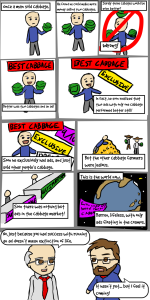Part One of Ad Review; Implementation Review
 I spent a lot of time researching how best to implement ads into the site for revenue – on one hand as the Print! comic the picture here comes from suggests I have a vague suspicion an ad driven business is the slippery slope to the extinction of all life on earth, on the other hand I do need to make money off the site some day, and as much as I like the concept of Patreon, it’s hardly realistic as a revenue source for a newcomer to scene such as myself (hope may spring eternal, but it has yet to start paying rent).
I spent a lot of time researching how best to implement ads into the site for revenue – on one hand as the Print! comic the picture here comes from suggests I have a vague suspicion an ad driven business is the slippery slope to the extinction of all life on earth, on the other hand I do need to make money off the site some day, and as much as I like the concept of Patreon, it’s hardly realistic as a revenue source for a newcomer to scene such as myself (hope may spring eternal, but it has yet to start paying rent).
So… let’s talk ad implementation. I will probably make posts about this – one about implementation (this one) and one about results and suggestions (though there are some details you cannot go into, there is some general ones you can).
The three types that most directly apply to blogs and webcomics are Project Wonderful, Google Adsense, and Comic Rocket.
Project Wonderful:
I do like Project Wonderful – and I want to like it more. Their hook for their ads are that they are easy, transparent, and fair. These are valid selling points.
This is the set up:
1) Register on their site.
2) Submit your site for approval.
3) Twiddle your thumbs for few days.
4) Follow their detailed and helpful directions about how to implement their ads onto your site (included sections specifically for WordPress and Blogger users).
That’s pretty much it, and that’s good and bad. On the bright side, its pretty easy – on the downside, there is pretty limited opportunities for optimizing the revenue. It’s pretty much just wait for bids, and with a moderate traffic site, this is going to be pretty slim pickings.
Pros: Easy to use, easy to get paid, and you can completely control what ads appear on your site if your willing to take a pretty big revenue hit to manually approval all your ads.
Cons: Pretty limited revenue stream unless you enable network ads (this is unlocked at high enough traffic); and once you unlock network ads you lose a lot of control over what ads appear on your site, including ads that tend to verge into things you’d rather not have (flashing ads, ads that lead to dubious sites, etc).
Review: 🙂
Thoughts: I wish their network ad system had less spammy stuff on it, and there were more advertisers with money to spend on the system.
Comic Rocket:
Comic Rocket is a mixed bag. On one hand they seem to be trying for the transparent and easy to use style of Project Wonderful, with even more clear cut rules on what you make and how you make it. On the other hand their customer service is horrible to the point of being an issue. I don’t mean this in a mean way – the one guy I managed to get to talk to was both nice and extremely helpful. And than he went silent for weeks and I never heard back from him, and that tends to be the theme with them.
The process is similar to comic rocket.
1) Submit your comic to Comic Rocket.
2) Claim your comic – wait a few days.
3) Register your comic to be a publisher… wait a few weeks?
4) Place the ad code unto your site – they don’t really provide clear directions for dummies like me on this, but its in fact the same as Project Wonderful for WordPress, copy both the async and the box code into text widget -> place text widget where you want ad -> have an ad.
It’s hard to make a call – I’d like to like it, but it isn’t really comparable to Project Wonderful in terms transparency. You will frequently be left wondering if your ad is working, if you will get paid for it, or if Comic Rocket as a company still exists. These are things you should not really be left wondering when you run ads – unhelpful is one thing, dead silent is more worrisome. As a word of advice for WordPress/ComicPress users, the Comic Rocket WordPress Plugin does not work for paid ads, even if it displays ads, it is not working (as of this blog post).
Pros: While not exactly clear, it is easy to implement them – copy both pieces of code into a Text widget if you are using WordPress, if you have your own site, it provides directions, but it does function like most any other ad placement. Their payout is fair and transparent in terms, if it’s really hard to tell if its working in practice. Their ads seem to load for adblock users (this seems true in my testing, I don’t really understand, but seems like a pretty major pro!); their ads in my experience entirely webcomic ads – meaning typically ads you want to run if you are webcomic, since your users actually might want to see them (novel for an ad).
Cons: At the end of the day they are a black box – having trouble getting the ad box on your site? Good luck… Have questions about how the stats are tracked? Problems? Yeah… probably not going to hear anything on that. I try to give them the benefit of the doubt as I imagine they are fairly small enterprise, but they are clearly not really in the business of retaining publishers.
Review: 😐 (unfortunately)
Thoughts: Their system seems like it was made with good intentions, but the complete lack of customer service is dubious at best considering that it’s implementation is a bit rocky and unclear.
EDIT: It should be noted shortly after this post I changed to using a Comic Rocket Leaderboard – either those don’t work or the system finally decided to commit suicide entirely as it stopped counting pageviews. Despite the fact that I like their ads (since they are all webcomics), I had to let the ads go, and filling up the slot with a second adsense ad (for now).
Google Adsense:
When talking about Google Adsense the old saying “easy to use, hard to master” comes to mind. When making a game, that’s a good thing in theory. When trying to run ads on your site… eh, not so much.
The process should be familiar.
1) Make account.
2) Submit site for review.
3) Get ad code -> paste adcode onto site.
It takes a little longer to get approved and will require a bit more user information than the other methods here, but is ultimately the same general process. The Pro and the Con with adsense is that getting the ad onto your site is the beginning of the journey rather than the end. I won’t get into optimization (as I’m not really qualified), but suffice it to say there there are entire sites and full books dedicated to how this works, and they read more like voodoo ritual instructions than web mastering.
How well they work is up for some debate… it’s pretty hard to tell anything – while Google is fairly transparent on your stats, they are pretty obtuse on how you got there or how to improve them – it makes sense as they in a cosmic war with scammers, but means that you caught in the middle will be a little outta luck on the optimization front.
Pros: There is a reason that almost every major traffic site uses these things. Without touching on the details of how much money any of them makes, Project Wonderful simply doesn’t have many high paying advertisers on the network, while Google has the ads of the biggest industries in the world. Additionally Google tends to curate ads to be at least somewhat reasonable (you rarely see malicious ads like crop up on PW Network ads occasionally, and I haven’t had any problems with spamming/flashing ads yet).
Cons: If you don’t optimize and you don’t have much traffic, you shouldn’t have much expectations. If you want profits here, you will work for profits here. Some people don’t like Google’s tendencies to track advertising target and view them as creepy. They will frequently not be relevant to your site (ie: less likely things your readers see as a positive thing to have on your site, and more likely to make them adblock you).
Review: 😡 to 🙂 depending on how much effort you want to put in.
Thoughts: Best for people that are either quite serious about their business or are fans of black magic rituals. They probably want to be sun shine and puppies, but their long war with scammers has left the service less than friendly and transparent.
If you have thoughts on any of the above, have questions about the implementation of them on a WordPress/ComicPress site, or just want to chime either comment below or drop me a line via the information on the contact page.







Discussion ¬